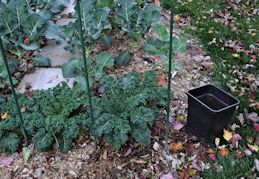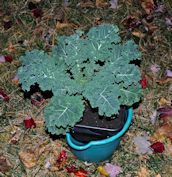In the first picture I'm digging up some kale from a place that curently has kale and broccoli. The green-painted rebar are part of the trellis I leave in place from the spaghetti squash from the summer. I add good compost into the pot with the kale and then put it into a pale filled with tepid water - actually more like "warm" than "tepid" - to soak from the bottom-up giving it a good start in it's new environment.
The fourth picture is me standing (proudly) with it in front of the big white grow room door before taking it inside, hoping to better show the large size of the potted plant which the other pictures don't do so well. The grow room cart can hold twelve pots this size, and can be easily rolled out to access the other potted plants for watering and harvesting - optimizing the space for growing.
And then finally it's put on the cart with the tomato plants. If you look closely, you can see that some cedar mulch has been added in all the pots. Even though the grow room is inclosed, various flying insects will still find their way in and attempt to lay eggs in the soil, and the larvae from them would then feast on the roots. One example of a flying insect is the crane fly, sometimes thought to be a "mosquito eater" since it looks like a huge mosquito, will lay it's eggs in soil and the larvae will then feed on the roots of whatever vegetaions happens to be in that soil. Fungus gnats can also become a problem in a place like the grow room, greenhouses, or other similar spaces where organic soils are used. The cedar mulch acts as a barrier between bug and soil. Keeping the mulch dry by watering in the saucer below, or pulling back the mulch when watering from the top will further aid in making an unwelcome egg-laying environment for the insects.
The grow room cart will soon be filled with more kale, swiss chard, and cucumber as well as the tomato plants, where they'll spend the winter months providing us with some our salad needs during the winter months, along with other things growing elsewhere in the grow room as well as within the house in lighted "grow spaces."
|




